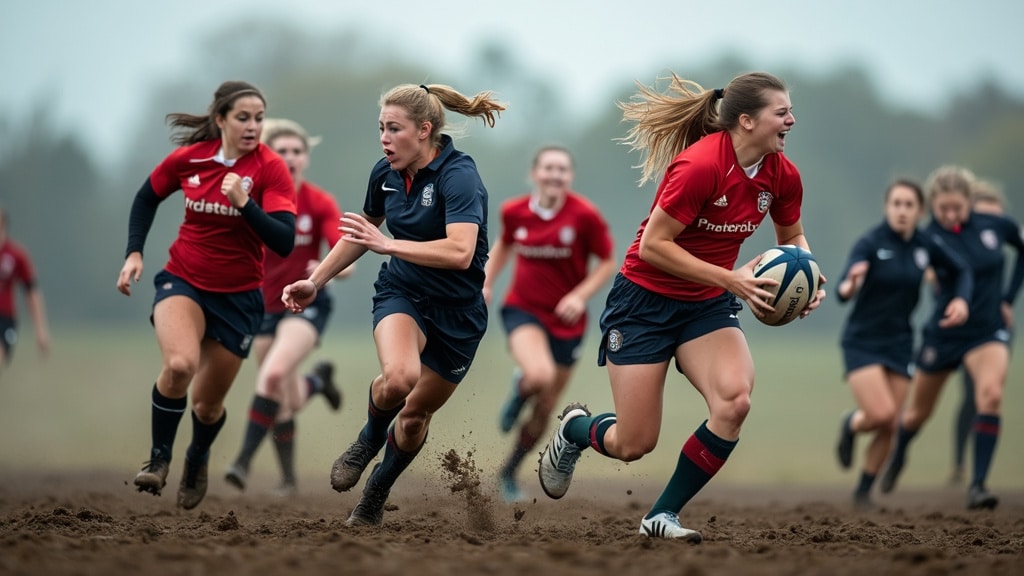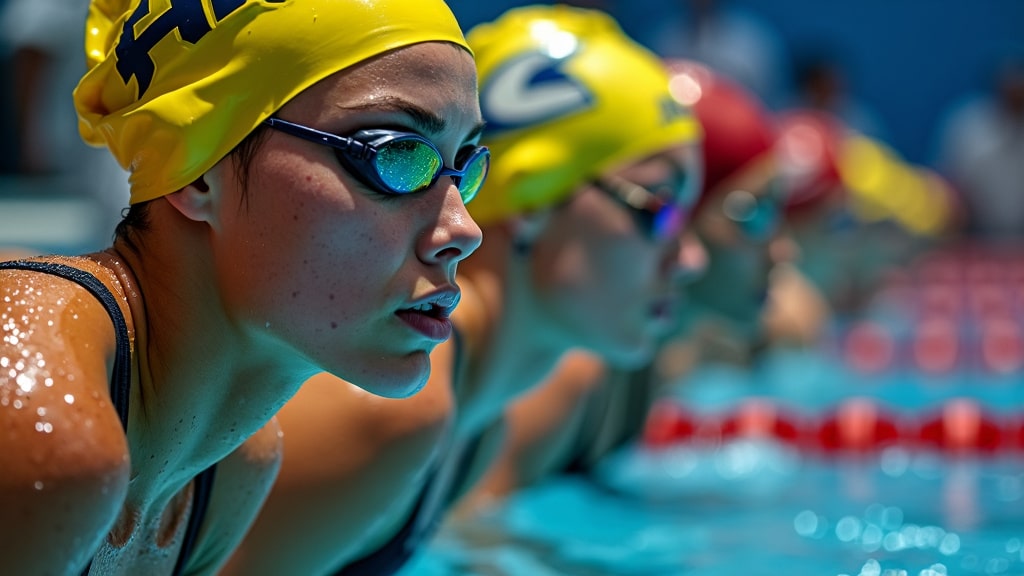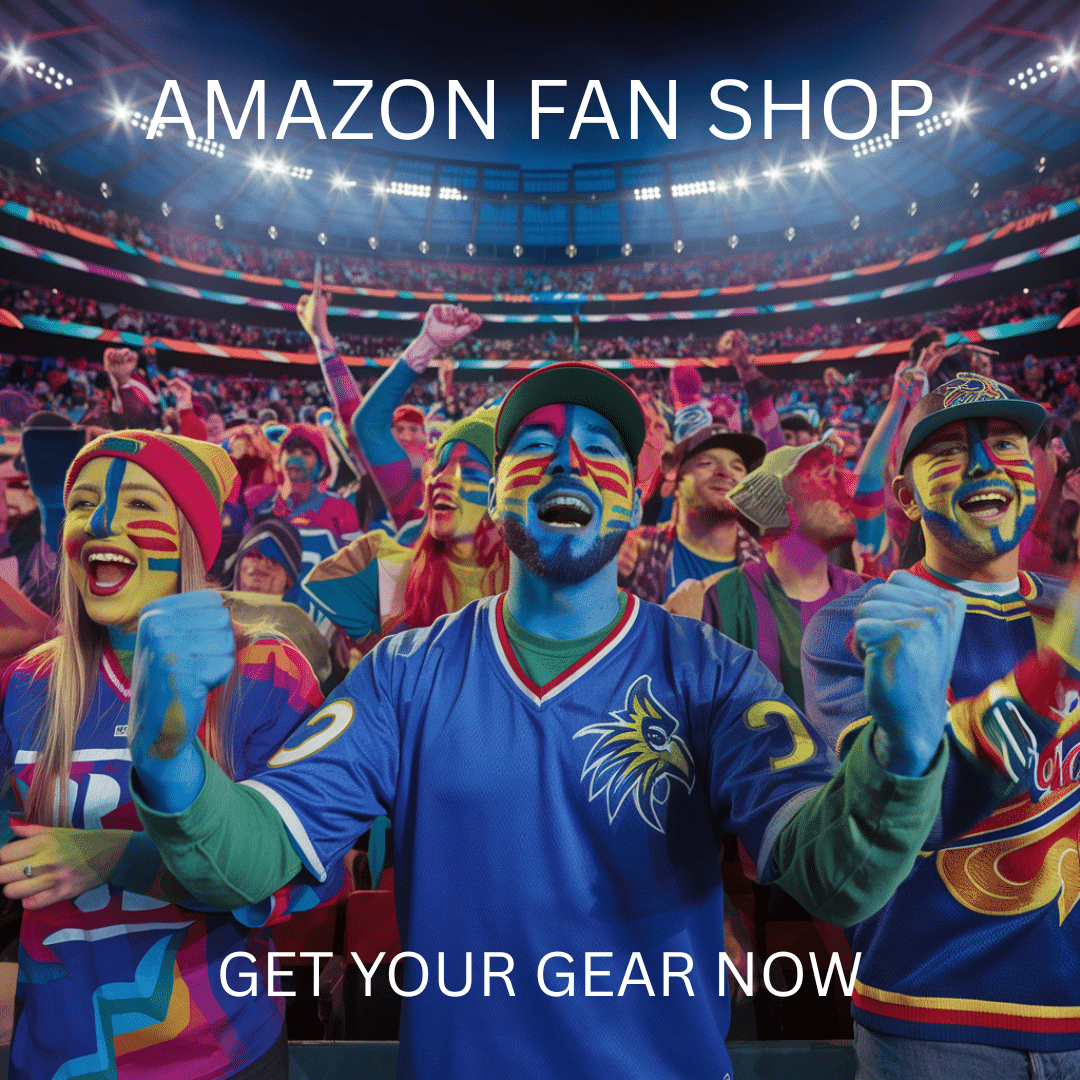NIL Opportunities College Female Sports: Expanding Horizons and Career Paths
In recent years, the landscape of college sports has seen transformative changes, particularly with the introduction of Name, Image, and Likeness (NIL) opportunities. These changes have opened doors for student-athletes, including women, to capitalize on their talents beyond the field or court.
Women in college sports are now able to secure NIL deals, bringing new financial opportunities and recognition that were previously out of reach.

Despite progress, there remains a discrepancy in NIL deal distribution. According to a new report, only 34% of NIL deals go to women athletes, highlighting the ongoing challenges in achieving equity.
Nevertheless, sports such as women’s basketball show promising signs, ranking third-highest among NIL compensated sports.
Athletes such as Mia Mastrov and Jordan Chiles exemplify the potential for women to thrive under the NIL framework, with Mastrov earning $329,000 through her deals. These success stories underscore the growing impact of NIL opportunities, driving change in the landscape of college athletics and offering female athletes new avenues to succeed financially and professionally.
Overview Of NIL In College Sports
Table of Contents
- 1 Overview Of NIL In College Sports
- 2 Importance Of Understanding Historical Context
- 3 Focus On Female Student-Athletes
- 4 Early Beginnings Of NIL Discussions
- 5 Pivotal Legislative Changes
- 6 Landmark Events
- 7 Societal Shifts Influencing NIL
- 8 The Impact On Female Student-Athletes
- 9 Current Landscape Of NIL Rights
- 10 Conclusion
- 11 Frequently Asked Questions
- 11.1 How do female athletes benefit from NIL agreements?
- 11.2 Who are the highest-earning female athletes in college sports due to NIL?
- 11.3 What are the most lucrative NIL opportunities for women in NCAA sports?
- 11.4 How has the NIL policy impacted earnings for women in college basketball?
- 11.5 In which women’s sports are NIL deals most prevalent?
- 11.6 What factors contribute to the value of NIL deals for female college athletes?

The introduction of NIL, or name, image, and likeness, has transformed college sports. Athletes are now able to profit from their personal brands by signing endorsements and sponsorships.
NIL Basics:
- Athletes can engage in commercial activities.
- They can sign contracts and make money from their talents.
- This includes football players, basketball players, and more.
The National Collegiate Athletic Association (NCAA) initially resisted these changes, keeping amateurism rules strict. The landscape shifted when states passed laws supporting NIL rights. The NCAA had to adapt, and rules were revised.
Impact on Athletes:
- College athletes across various divisions, especially in Division I, have seen significant changes.
- Compensation through NIL deals offers them financial support previously unavailable. This applies to both men and women athletes.
Notable Examples:
- Haley and Hanna Cavinder from the University of Miami.
- Olivia Dunne, a gymnast from Louisiana State University.
They leveraged their social media presence to gain substantial NIL deals.
Benefits:
- Financial Literacy: Athletes learn to handle money, pay taxes, and sign legal contracts.
- Exposure: NIL breaks down barriers, especially for women athletes, enabling them to gain visibility and earn money.
Challenges:
While many benefits have emerged, disparities and complexities still exist. Ensuring equity across all sports and divisions remains a concern.
By allowing athletes to monetize their identities, NIL has reshaped college sports, paving the way for increased autonomy and financial independence.
Importance Of Understanding Historical Context

Understanding the historical context is crucial when discussing NIL (Name, Image, and Likeness) opportunities for female college athletes. It helps highlight the progress and remaining challenges in the fight for gender equity in sports.
Title IX played a significant role in advancing women’s sports by mandating equitable funding and opportunities. Before its enactment, female athletes had fewer resources and less recognition.
Book Your Dream Vacation Today
Flights | Hotels | Vacation Rentals | Rental Cars | Experiences
Despite progress, inequities persist. Male athletes often receive more funding and media coverage. This disparity affects their visibility and opportunities in the NIL space.
Equity in sports is not just about equal resources but also about fair treatment. NIL opportunities can help bridge this gap by allowing female athletes to capitalize on their talents and followings.
Equitable treatment ensures that women athletes have the same opportunities as their male counterparts. This includes fair compensation for endorsements and other NIL deals.
Historical context shows the journey from limited support to current funding opportunities. Female athletes today benefit from the groundwork laid by past advocates of gender equality in sports.
The labor of previous generations of female athletes who fought for equal opportunities cannot be overlooked. Their efforts paved the way for today’s progress in equitable NIL opportunities.
Focus On Female Student-Athletes
Female athletes in college sports are gaining more attention and opportunities thanks to NIL deals. This shift began in 2021, when the Name, Image, and Likeness policy came into effect, transforming the landscape for NCAA athletes.
Female student-athletes are now able to build their personal brands. Notable examples include Haley and Hanna Cavinder, twin basketball players from the University of Miami.
Sports Dominance
Women’s sports like basketball, volleyball, and softball have seen a notable increase in NIL activities. In some cases, they have even surpassed their male counterparts.
| Sport | NIL Activity Share |
|---|---|
| Women’s Basketball | High |
| Women’s Volleyball | High |
| Softball | High |
Representation
Representation in NIL deals is crucial for female athletes. Despite the progress, women still face challenges. Only 34% of NIL deals go to female athletes, compared to 66% for male athletes.
College Sports Examples
Female athletes in sports like gymnastics and softball are also benefiting. LSU gymnast Olivia Dunne has utilized her social media presence to become a top earner.
Challenges
Despite the progress, female college athletes continue to fight for equal opportunities in NIL deals and representation. The disparities in the distribution of NIL deals highlight the ongoing struggle for gender equity in college sports.
Early Beginnings Of NIL Discussions
Discussions around Name, Image, and Likeness (NIL) policy in college sports began years before its official implementation. These discussions were marked by debates over compensating athletes, the influence of social media, and key advocates who pushed for NIL rights.
Initial Debates On Athlete Compensation
The debate over athlete compensation stemmed from the growing commercial success of college sports. Many argued that while universities profited from athletics, the students themselves saw no financial benefit.
This led to heated discussions about fairness and equity.
Critics of athlete compensation believed paying athletes would disrupt the amateur status of college sports. Supporters countered that athletes deserved a share of the revenue they helped generate, often risking injury and balancing academics.
The Role Of Social Media And Public Opinion
Social media played a crucial role in shaping public opinion on NIL rights. Platforms like Twitter and Instagram allowed athletes to voice their frustrations and highlight the discrepancy between their efforts and their compensation.
Public campaigns urged the NCAA to reconsider its stance on athlete compensation. The widespread use of hashtags and viral posts created a groundswell of support, drawing attention from mainstream media and forcing the NCAA to take notice.
Key Early Advocates For NIL Rights
Several key figures emerged as advocates for NIL rights. Former athletes, legal experts, and sports commentators voiced their support, using their platforms to influence public opinion and policy.
One notable advocate was Ed O’Bannon, a former UCLA basketball player, who led a lawsuit against the NCAA. His efforts brought significant attention to the issue and set the stage for policy changes. Other athletes followed suit, adding their voices to the growing call for NIL rights.
Pivotal Legislative Changes
Significant legislative changes have reshaped the landscape for female college athletes regarding Name, Image, and Likeness (NIL) rights. These transformations include shifts in NCAA policies, pivotal court rulings, and new state laws that have altered opportunities and equity in college sports.
The NCAA’s Initial Stance On NIL Rights
The NCAA has long maintained strict rules around amateurism, prohibiting student-athletes from earning money through endorsements or other NIL opportunities. This stance changed as public and legislative pressure mounted.
Initially, the NCAA opposed any forms of payment to athletes, asserting that it would undermine the amateur status of college sports.
However, in response to increasing calls for fairness and equity, the NCAA began to soften its stance.
In recent years, they have adopted more lenient policies, allowing student-athletes to profit from their NIL. The NCAA’s gradual shift is a key factor in the current landscape of college athletics.
Influential Court Cases And Rulings
Several court cases have played critical roles in changing NIL regulations.
A landmark case, O’Bannon v. NCAA, challenged the use of college athletes’ images and likenesses in video games without compensation. The ruling favored former UCLA basketball player Ed O’Bannon, setting a precedent for athletes’ rights to their NIL.
Another significant case, NCAA v. Alston, further dismantled the NCAA’s amateurism rules.
This case reached the U.S. Supreme Court, which unanimously ruled that the NCAA could not limit education-related benefits for athletes.
These court decisions were pivotal in advancing NIL rights and opportunities for college athletes, including female student-athletes.
Introduction of State-Level NIL Laws
Individual states began to take matters into their own hands by introducing NIL laws.
California led the charge with the Fair Pay to Play Act, which allowed college athletes in the state to profit from their NIL starting in 2023.
This law prompted other states to pass similar legislation, creating a patchwork of rules across the country.
These state-level initiatives forced the NCAA’s hand, compelling them to adopt a more uniform policy.
States like Florida, New York, and Texas quickly followed California’s lead, ensuring that student-athletes nationwide had opportunities to benefit financially from their NIL. These state laws significantly impact equity and opportunity for female athletes in college sports.
Landmark Events
The path to NIL opportunities for college female athletes has seen several significant milestones. These events have redefined the playing field, leading to the historic changes in 2021 that allowed athletes to profit from their name, image, and likeness.
The Impact Of The O’Bannon Case
The O’Bannon case began in 2009 when former UCLA basketball player Ed O’Bannon filed a lawsuit against the NCAA. He argued that the NCAA unfairly profited from athletes without compensating them. This case highlighted the imbalance in college sports, particularly for athletes whose images and likenesses were used without payment.
In 2014, a federal judge ruled in favor of O’Bannon, leading to changes in how athletes could be compensated. This case set a crucial precedent, proving that athletes should have the right to profit from their personal brands. It was a significant moment for female athletes, as it laid the groundwork for future NIL legislation.
The Fair Pay To Play Act
The Fair Pay to Play Act was signed into law in California in 2019. This law allowed college athletes in California to earn money from endorsements starting in 2023.
It served as a catalyst for similar legislation across the country. The Act was not just about financial gain; it recognized athletes’ rights and shifted the power dynamics in college sports.
Female athletes benefitted significantly from this law. It acknowledged their marketability and encouraged other states to adopt similar policies. This legislative change was a decisive step towards equality and recognition in women’s sports.
The NCAA’s Rule Change In 2021
On July 1, 2021, the NCAA enacted a policy change that allowed college athletes to profit from their NIL. This rule change was historic, as it officially ended the NCAA’s long-standing prohibition on athlete compensation.
It marked a new era where athletes could engage in sponsorships, endorsements, and other financial opportunities.
Female athletes, in particular, saw new opportunities to monetize their visibility and skills. Brands recognized their influence and potential, leading to increased endorsement deals.
This policy change has been transformative, offering female athletes a platform to build and profit from their personal brands.
Societal Shifts Influencing NIL
NIL (Name, Image, Likeness) opportunities for female college athletes have grown due to changing societal attitudes, activism, and media. These shifts have significantly shaped how female athletes engage with brands and audiences.
Changing Attitudes Toward Athlete Compensation
Historically, the idea of paying college athletes faced resistance. Recently, there’s been a notable change. Society is starting to see athlete compensation as fair and necessary.
Female athletes, who often faced disparities in compensation, are now gaining more opportunities.
This change is partly due to the rise of social media platforms like Instagram and TikTok. Female athletes have used these platforms to build strong personal brands.
They connect directly with fans and showcase their athletic skills and personalities. Brands see the value in partnering with these athletes, who often have devoted followings.
This increased visibility and engagement on social media helps shift public opinion towards supporting athlete compensation.
The Role Of Activism And Advocacy Groups
Activism and advocacy play a crucial role in promoting equity in college sports. Organizations like Voice in Sport and various nonprofits are vocal about the importance of fair compensation for female athletes.
These groups highlight the disparities between male and female athletes and push for change. Advocacy efforts have led to significant legislative advancements.
For example, recent state legislation aims to ensure equity in collegiate sports. Advocacy from these groups has driven public awareness and generated more support for female athletes.
This results in better NIL opportunities and a more level playing field.
Media Coverage And Public Perception
Media coverage has significantly influenced public perception of NIL in college sports. Traditional media outlets and newer platforms like Forbes and Meta provide extensive coverage of the developments.
Positive stories and features on female athletes who benefit from NIL deals increase public support and awareness.
Social media amplifies this effect. Female athletes can share their stories directly with the public. Influencers and content creators also play a role in shifting public perception.
They often highlight the achievements and challenges of female athletes, making their voices heard. This media attention helps in reshaping public attitudes and promoting acceptance of NIL in college sports.
The Impact On Female Student-Athletes
Female student-athletes face a unique landscape of opportunities and challenges when it comes to NIL deals. Some athletes have successfully leveraged their image to gain significant partnerships, while others still struggle to attain equity in this realm.
Opportunities And Challenges For Female Athletes
NIL deals provide female athletes with new avenues for exposure and financial gain. Social media platforms allow athletes like Olivia Dunne and Paige Bueckers to monetize their large followings through lucrative partnerships.
Companies like Gatorade, Target, and Gymshark often collaborate with high-profile female athletes, showcasing the potential for significant earnings.
Challenges persist, however. Despite opportunities, female athletes receive only about one-third of the deals compared to their male counterparts. This disparity highlights ongoing inequities within collegiate sports.
The struggle for equal opportunities continues, echoing the long-standing battle for gender equity in sports.
Success Stories Of Female Athletes Leveraging NIL
Some female athletes have become trailblazers in the NIL landscape. For instance, the Cavinder twins, Haley and Hanna, have signed multiple deals with brands like Forever 21 and Raising Cane’s, showcasing their ability to attract major sponsorships.
These deals not only bring monetary benefits but also help increase their public visibility.
Another notable example is LSU gymnast Olivia Dunne, who has leveraged her social media presence to land endorsements with companies like Amazon and Gatorade.
Similarly, basketball player Jada Williams has partnered with Spalding, proving that high-profile athletes can attract significant professional opportunities.
Specific Strategies For Maximizing NIL Potential
Athletes can maximize their NIL potential through several strategies. Building a strong social media presence is critical. Engaging content, regular updates, and genuine interactions with followers can increase visibility and attract brands.
Partnerships with brands should align with the athlete’s personal brand. Careful selection of partnerships with reputable companies like Target or Gymshark can enhance credibility. Additionally, appearances at events and active participation in community initiatives can amplify an athlete’s profile.
Networking with industry professionals and utilizing available platforms, such as Opendorse, can also be beneficial. These steps ensure athletes not only gain monetary benefits but also champion their long-term professional goals.
Current Landscape Of NIL Rights
The landscape of Name, Image, and Likeness (NIL) rights in college female sports is evolving rapidly with significant implications for athletes. This section examines the current regulations, market trends, and the necessity of compliance and education.
Overview Of Present-Day NIL Regulations
NIL regulations were introduced in July 2021, allowing college athletes to profit from their name, image, and likeness. The NCAA oversees these policies but leaves room for individual states and schools to set additional guidelines. Most colleges, such as Aquinas College, follow both state laws and institutional policies aimed at facilitating NIL deals for female athletes.
NIL collectives are groups that pool resources to support athletes, often navigating the complicated NIL marketplace. This system creates opportunities, though disparities remain in the distribution of deals between male and female athletes.
Analysis Of Market Trends And Opportunities
Market trends in NIL rights show a promising future for female athletes. According to reports, NIL deals skew heavily towards male athletes, securing 66% of deals. Despite this, sports like basketball, softball, and volleyball lead for women, with basketball making up 22.7% of NIL deals in Power Four women’s sports.
Companies like Opendorse and On3 provide platforms for athletes to connect with potential sponsors. These platforms help enhance visibility and career opportunities, encouraging greater equity in sports endorsements.
The Role Of Compliance And Education For Athletes
Compliance and education are crucial for navigating NIL rights. Many institutions, including the NCAA, offer programs to educate athletes about contract law, financial literacy, and brand management. The NCAA x Meta NIL Empower Program is a notable example, aiming to empower female athletes specifically.
Understanding NIL rules is essential for avoiding pitfalls that could jeopardize eligibility or future opportunities. Schools, through workshops and support services, ensure athletes are well-versed in compliance to maximize their NIL earning potential.
Conclusion
Summary Of Key Developments
The arrival of NIL (Name, Image, and Likeness) deals has revolutionized the landscape for college female athletes. High-profile athletes like the Cavinder twins and LSU gymnast Olivia Dunne have gained substantial exposure and earnings.
This new dynamic has allowed women to bypass traditional barriers and make significant use of social media for personal branding. Despite this progress, there remains a noticeable imbalance, with men historically securing more NIL deals and higher compensation.
Reports indicate that only 34% of NIL collectives engage with women athletes, underscoring a need for broader equity.
The Future Of NIL Opportunities
Looking ahead, the future holds promise for expanded NIL opportunities for female athletes. Continued advocacy and heightened awareness can help bridge the gap between male and female NIL deals.
Social media will remain a critical platform for female athletes to amplify their visibility and marketability. There is potential for new partnerships and sponsorships as brands recognize the value and influence of women in sports.
Efforts to ensure a fairer distribution of these opportunities will be crucial in achieving gender equity in college athletics.
Final Thoughts On The Impact On Female Athletes
The impact of NIL on female athletes has been transformative, allowing them to achieve financial independence while promoting gender equity.
Women have leveraged NIL to build their brands and gain a stronger voice in the sports community. While challenges persist, the progress made underlines a promising shift towards more balanced representation and opportunities for women in college sports.
Continued efforts to address disparities and support female athletes will be key to ensuring equal benefits for all college athletes.
Frequently Asked Questions
Female athletes are navigating a new landscape where they can profit from their name, image, and likeness (NIL). This section addresses some common queries about NIL opportunities for women in college sports.
How do female athletes benefit from NIL agreements?
Female athletes gain the chance to earn money while building their personal brand. This can lead to financial independence and professional growth. NIL deals also provide platforms for advocacy and visibility in sports.
Who are the highest-earning female athletes in college sports due to NIL?
Gymnasts and basketball players often top the list. Athletes like Olivia Dunne of LSU and Paige Bueckers of UConn are known for securing substantial deals. These athletes leverage their significant social media followings to attract lucrative contracts.
What are the most lucrative NIL opportunities for women in NCAA sports?
Social media endorsements, merchandising deals, and appearances are some of the most profitable avenues. Partnerships with brands in fitness, apparel, and health are particularly popular. Platforms like Instagram and TikTok play a crucial role in connecting athletes with brands.
How has the NIL policy impacted earnings for women in college basketball?
NIL policy changes have opened new financial doors for women in college basketball. Athletes can sign endorsement deals, promote products, and participate in sponsored events. This shift has brought a previously restricted source of income into play.
In which women’s sports are NIL deals most prevalent?
NIL deals are widespread in sports like basketball, gymnastics, and volleyball. These sports have strong followings and athletes active on social media, making them attractive to sponsors.
Gymnastics, in particular, has seen a boom in NIL activity.
What factors contribute to the value of NIL deals for female college athletes?
Social media presence, athletic performance, and marketability are key factors.
Athletes with large followings and engaging content can secure higher-value deals.
The type of sport and its popularity also play significant roles in determining deal value.

